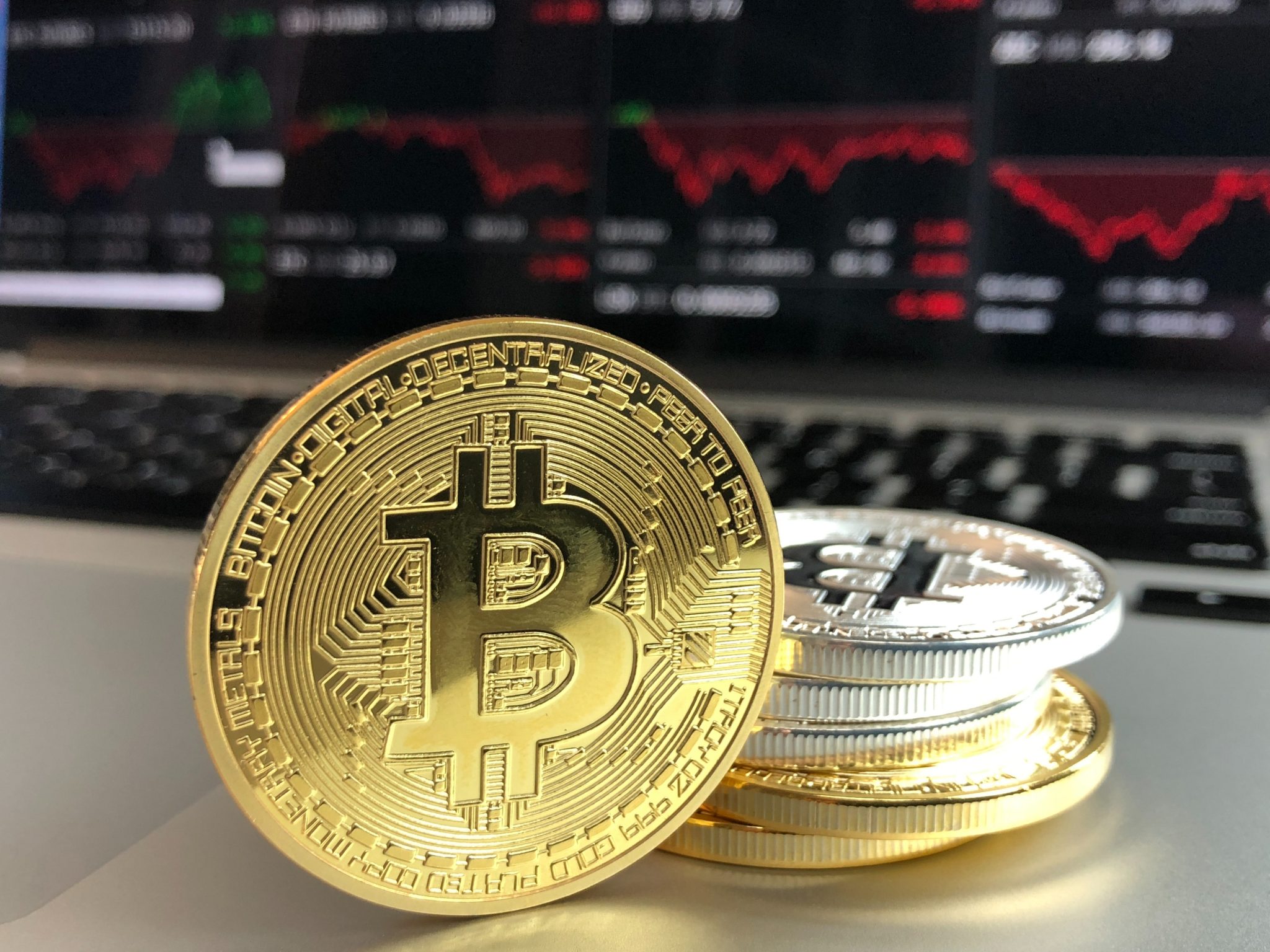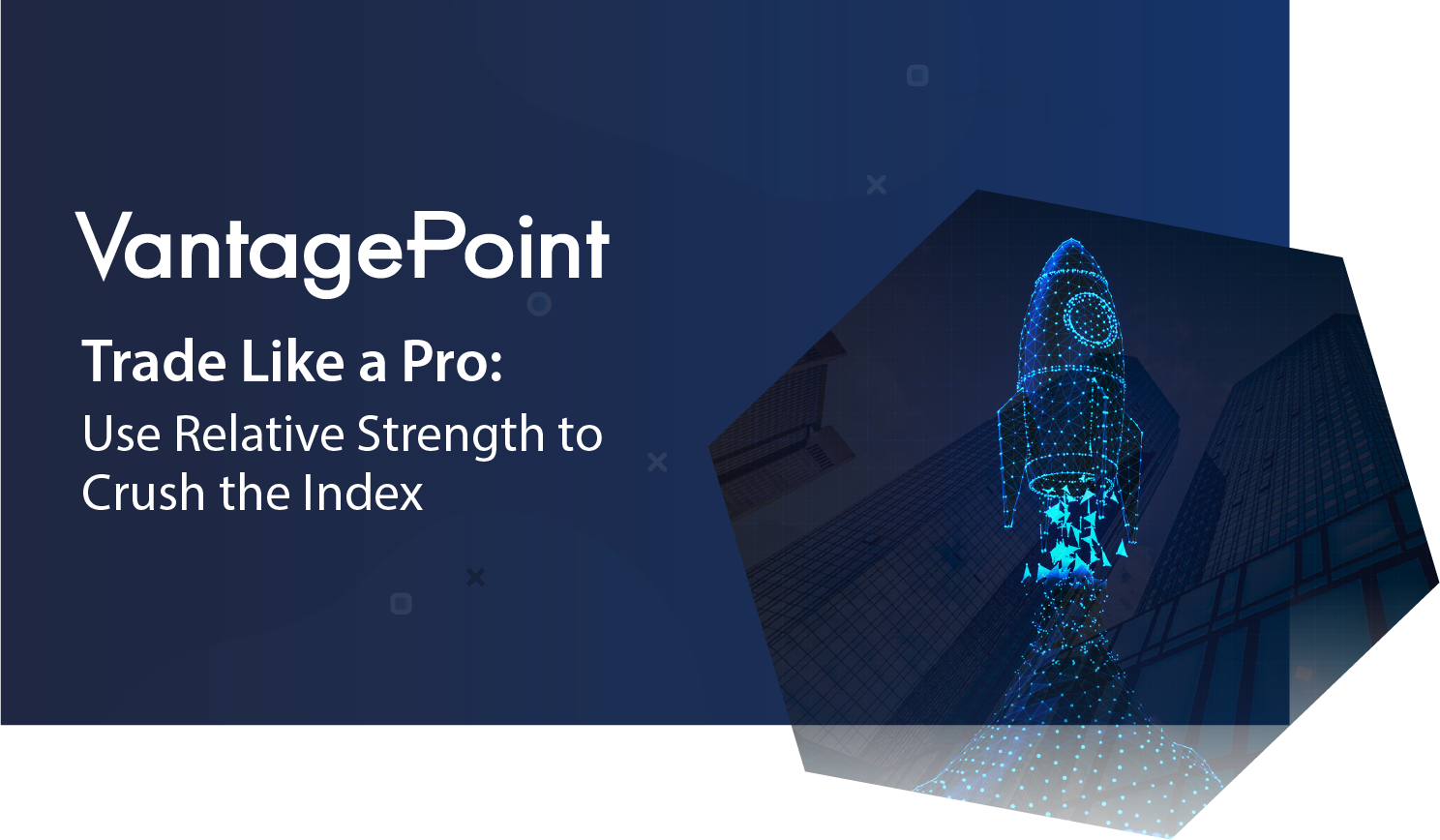What Comes After Bitcoin Trillions?
The trillion-dollar market capitalization club is a pretty elite group of players. Up until last week, the club only had 6 members: Apple (AAPL), Microsoft (MSFT), Amazon (AMZN), Google (GOOGL), PetroChina(PTR) and Saudi Aramco (SAR). This trillion-dollar benchmark is the high flying goal of all publicly traded companies.
Last week a new asset class hit the trillion-dollar valuation mark. At a price of $53,650 bitcoin entered these prestigious ranks. While bitcoin is not a stock, its rapid rise to the trillion-dollar level is forcing investors and traders at all levels to understand and re-evaluate it. Most traders and investors have to look at bitcoin multiple times before they begin to comprehend its nuances and possibilities to alter how finance and money have traditionally been done.
That trillion-dollar benchmark will force more and more skeptics to read the white paper and start their journey towards understanding bitcoin. Over each 24 hour period bitcoin consistently sees more than one million active addresses sending bitcoin totaling more than $17 billion daily. That is annualized to a $6 trillion rate. It has accomplished this feat by providing what the marketplace participants want – a store of value that is out of the hands of political meddling.
First off let’s look at some important benchmarks so that we can better understand why this new store of value is shaking things up! The chart below shows how long it took these leading companies to reach a trillion dollar market cap. I highlighted PetroChina because it is owned by the Chinese Government so, even though it is publicly traded it is controlled by leaders with access to unlimited sources of capital.
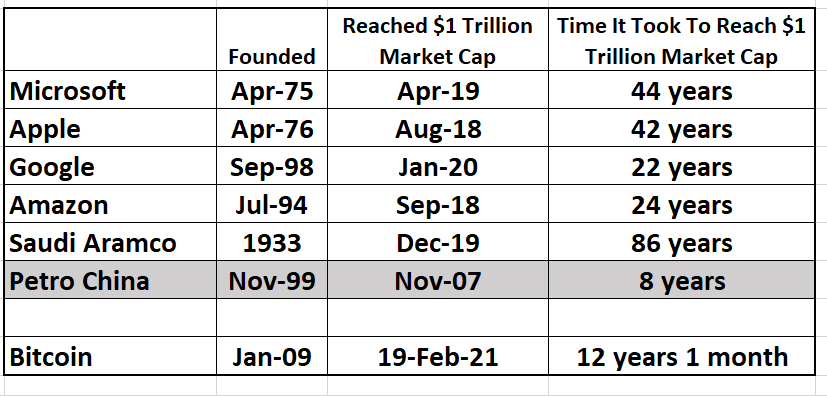
By all measures, bitcoin went from a valuation of zero on January 3, 2009 to a one trillion dollar market capitalization in only 12 years and 1 month.
While those statistics are impressive, the only question that is important in this regard is, why is bitcoin being adopted?
Let me share this perspective:

“If you catch 100 red fire ants as well as 100 large black ants, and put them in a jar, at first, nothing will happen. However, if you violently shake the jar and dump them back on the ground the ants will fight until they eventually kill each other. The thing is, the red ants think the black ants are the enemy and vice versa, when in reality, the real enemy is the person who shook the jar. This is exactly what’s happening in society today. Liberal vs. Conservative. Black vs. White, Rich vs. poor. Man vs. Woman. Cop vs. citizen. [Etc.] The real question we need to be asking ourselves is who’s shaking the jar… and why?”
The one thing we all share as we engage in trade with one another is money. The sad reality is that, in this author’s view, our money is broken. It does not store value and is easily debased by professional bureaucrats. Since 1971 when we came off the gold standard, Central banks and elected officials have been abusing the power and control they have over fiat currencies. They debase these currencies for decades and Bitcoin provides a welcome protection for individuals, corporations, and financial institutions. It is a means to protect the value of your savings. Since 1971 the U.S. dollar has lost more than 90% of its purchasing power.
Our monetary authorities continue to print new money into the economy and try to convince us that there will not be consequences to this action. Meanwhile, history tells a very different story.
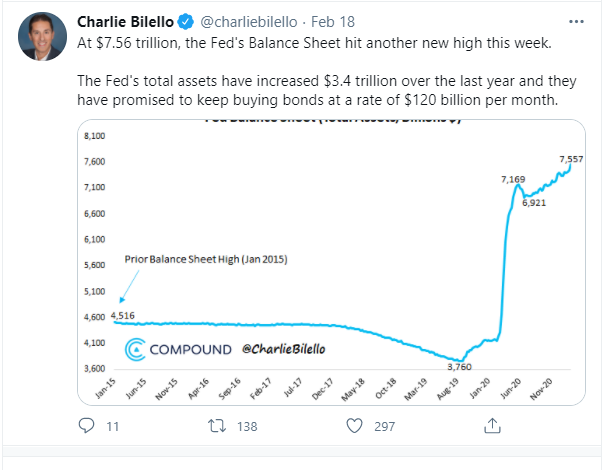
Trillions of new dollars are sloshing around the economy, most of them find a new home in financial asset prices creating new bubbles.
More importantly the headlines and economic reports communicate that all is well. But when even the most superficial analysis is done it is quite easy to see that the threat of currency debasement is unfolding in real time as economies around the world reinflate.
Or check out Beef Prices:
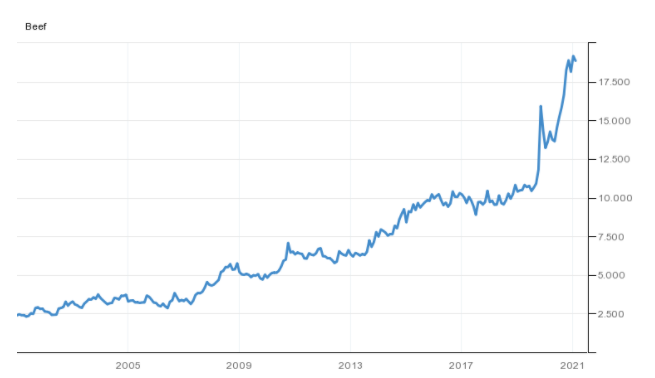
Beef Prices 2005 – Present
Or Lumber Prices:
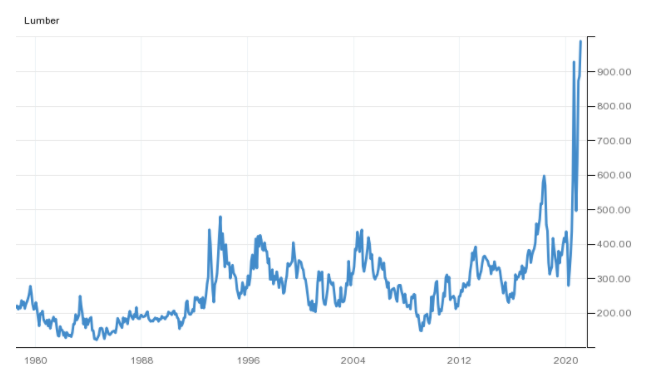
Lumber Prices 1980 to Present
The Federal Reserve is trying to reinflate at a 2% rate and is telling us that they have not reached that important metric. But when you look at the prices of metals, crude oil, beef and lumber over the past year they are clearly rising way beyond the 2% mark. How about your rent? Your health care cost? The cost of sending your kids to college? That new house you want to purchase?
Naturally, the Consumer Price Index does not measure those realities.
I can assure you all those things are increasing more than 2% per year. This is also why bitcoin adoption grows exponentially.
A few weeks ago, Tesla CEO Elon Musk reported that he placed $1.5 billion of his companies Treasury into bitcoin. All you have to do is evaluate the Feds policy and you can understand why Musk made this move.
The cornerstone of corporate finance is something referred to as the Real Rate of Return. It is calculated by subtracting the projected inflation rate from the 10 year Treasury Bond yield. The 10-year yield is currently at 1.37% when you subtract a 2% projected inflation rate you end up with a negative real rate of return. So, in other words, if you stay in cash you lose to inflation, and if you invest in U.S. Treasuries you still lose to inflation.
More importantly, let’s look at how this bitcoin investment worked out for TESLA and Musk. Over the past month, Tesla as earned over a one billion dollar profit from its bitcoin investment. Over the past year, Tesla reported net income of $969 million from its electronic vehicle sales. Let that sink in for a moment. Tesla has made more money in the past month from its bitcoin investment that it has made in the last year from selling cars!
Look at the following chart from the Saint Louis Fed, which shows year over year growth of the m2 Money supply:
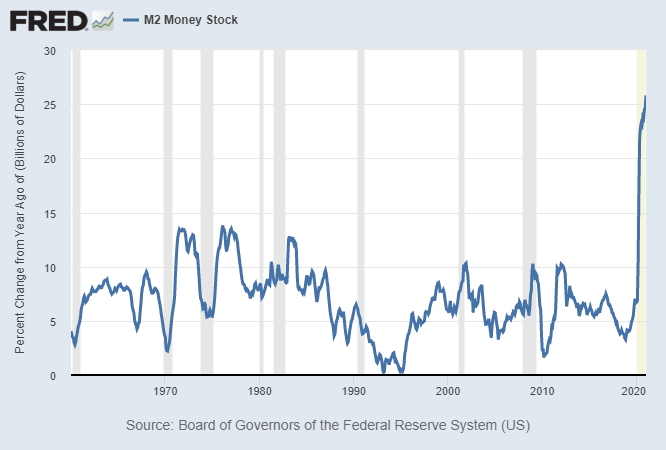
M2 Money Supply Year Over Year Growth
If we look at major countries’ broad money supply growth since the beginning of 2020, here are the approximate numbers:
- United States: 25%
- Canada: 18%
- UK: 14%
- Euro Area: 10%
- China: 10%
- Japan: 10%
Any way you slice these numbers they seem to communicate that a lot more money is chasing the same amount of goods around, and traditionally that is how inflation has always been defined.
Robin Brooks, former chief FX strategist at Goldman Sachs, posted a chart couple weeks ago that shows US Treasury security issuance as a percentage of GDP, compared to who is buying that Treasury issuance.
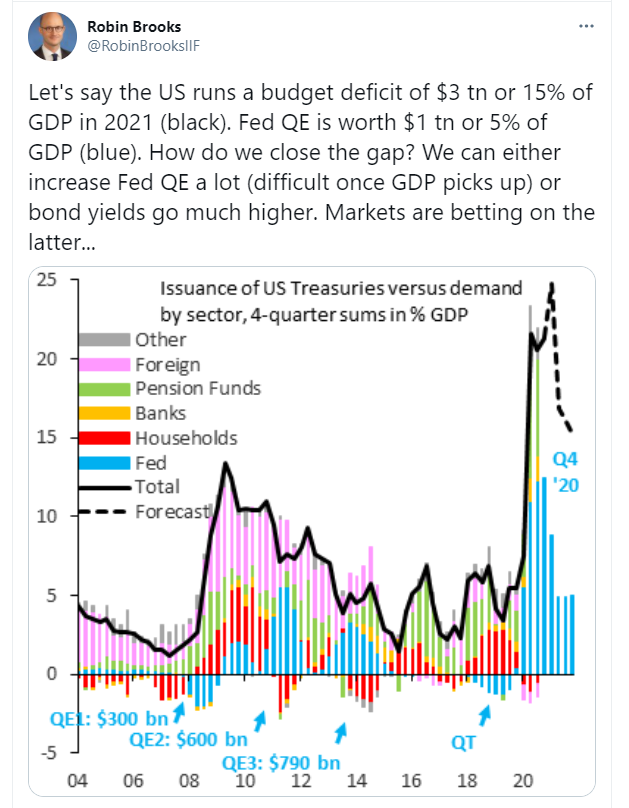
If interest rates increase as Robin Brooks implies, servicing the debt becomes exponentially more difficult. Thus, the real possibility of currency debasement. The Fed is the only entity buying Treasury securities because they are guaranteed to lock in a negative yield.
Last month the Chicago Mercantile Exchange and the Chicago Board Options Exchange launched bitcoin futures and options products. Massive institutional money has flowed into Bitcoin since this occurred. What this paves the way for is for something even bigger in the United States and that is the launch of a new Bitcoin ETF. This occurred in Canada two weeks ago and literally broke every record of adoption.
Purpose Investment’s ETF gives investors public market exposure to bitcoin and is traded on the Toronto Stock Exchange.
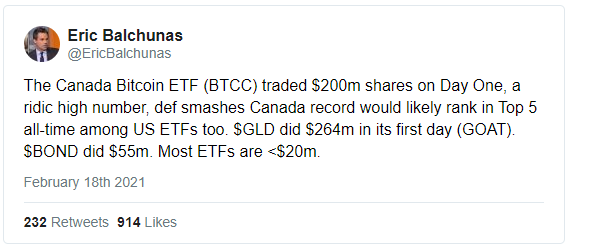
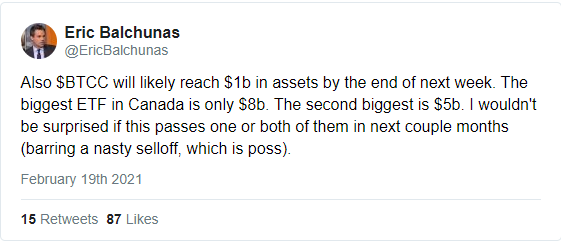
The centralized banking world is clearly being disrupted by bitcoins decentralized structure. Bitcoin is proving to be the exact opposite of the centralized banking system. It is only a matter of time since a Bitcoin ETF is launched in the United States. This will make it as easy for people to purchase bitcoin as buying any stock that Wall Street has to offer without the worries of having to custody your bitcoin. Since there will ever only be 21 million bitcoin the demand is fierce for the remaining 2.35 million bitcoins that remain to be mined.
The incumbents and legacy finance folks will claim Bitcoin is a bubble. Others, however, see bitcoin as a response to a fiat currency system that prevents wealth accumulation for those who need it most. To quote George Soros, whose Quantum Fund in the 1970’s returned 4200% when the S&P 500 returned just 47%:
“Economic history is a never-ending series of episodes based on falsehoods and lies, not truths. It represents the path to big money. The object is to recognize the trend whose premise is false, ride that trend, and step off before it is discredited.”
Bitcoin continues to outperform all other assets in all economic environments:
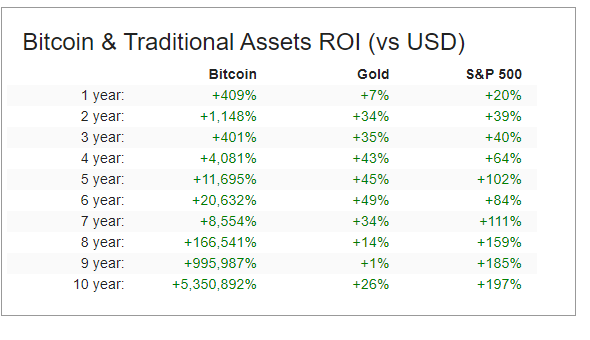
The race to debase is very real. This economic environment is forcing traders into much shorter time frames as everyone in the marketplace chases yield.
Real asset prices will keep rising as the yield chase intensifies. Cheap capital will keep flooding the market. And our economy will continue its addiction to a horrible monetary stimulus drug that is being handed out like candy in Washington DC.
Do you have the tools and ability to find the strongest trends at right time in this economic environment? What is your plan for maintaining your purchasing power as this trend accelerates?
I’d like to invite you to visit with us at one of our Live Masterclass Webinars where we show how artificial intelligence is the only means to stay consistently up to date on the risk and reward opportunities in this environment.
What all traders and investors want is an accurate, proven solution that alerts you when a high probability trend is unfolding. The Vantagepoint A.I. forecasts have proven to be up to 87.4% accurate in determining the trend three days in advance.
Visit With US and check out the A.I. at our Next Live Training.
It’s not magic. It’s machine learning.
Make it count.
THERE IS SUBSTANTIAL RISK OF LOSS ASSOCIATED WITH TRADING. ONLY RISK CAPITAL SHOULD BE USED TO TRADE. TRADING STOCKS, FUTURES, OPTIONS, FOREX, AND ETFs IS NOT SUITABLE FOR EVERYONE.IMPORTANT NOTICE!
DISCLAIMER: STOCKS, FUTURES, OPTIONS, ETFs AND CURRENCY TRADING ALL HAVE LARGE POTENTIAL REWARDS, BUT THEY ALSO HAVE LARGE POTENTIAL RISK. YOU MUST BE AWARE OF THE RISKS AND BE WILLING TO ACCEPT THEM IN ORDER TO INVEST IN THESE MARKETS. DON’T TRADE WITH MONEY YOU CAN’T AFFORD TO LOSE. THIS ARTICLE AND WEBSITE IS NEITHER A SOLICITATION NOR AN OFFER TO BUY/SELL FUTURES, OPTIONS, STOCKS, OR CURRENCIES. NO REPRESENTATION IS BEING MADE THAT ANY ACCOUNT WILL OR IS LIKELY TO ACHIEVE PROFITS OR LOSSES SIMILAR TO THOSE DISCUSSED ON THIS ARTICLE OR WEBSITE. THE PAST PERFORMANCE OF ANY TRADING SYSTEM OR METHODOLOGY IS NOT NECESSARILY INDICATIVE OF FUTURE RESULTS. CFTC RULE 4.41 – HYPOTHETICAL OR SIMULATED PERFORMANCE RESULTS HAVE CERTAIN LIMITATIONS. UNLIKE AN ACTUAL PERFORMANCE RECORD, SIMULATED RESULTS DO NOT REPRESENT ACTUAL TRADING. ALSO, SINCE THE TRADES HAVE NOT BEEN EXECUTED, THE RESULTS MAY HAVE UNDER-OR-OVER COMPENSATED FOR THE IMPACT, IF ANY, OF CERTAIN MARKET FACTORS, SUCH AS LACK OF LIQUIDITY. SIMULATED TRADING PROGRAMS IN GENERAL ARE ALSO SUBJECT TO THE FACT THAT THEY ARE DESIGNED WITH THE BENEFIT OF HINDSIGHT. NO REPRESENTATION IS BEING MADE THAT ANY ACCOUNT WILL OR IS LIKELY TO ACHIEVE PROFIT OR LOSSES SIMILAR TO THOSE SHOWN.





